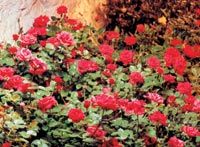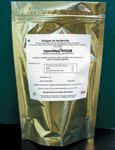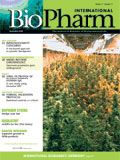Let There Be Light: Plant-Made Pharmaceuticals' New Home is Underground
The mine space is greater than the volume of all homes for a city of one million people. The second facility has been mapped at 22,500 acres.
It's not every day that a concept of utilizing an underground mine to grow pharmaceutically active plants jumps out and captures one's attention. However, in the evolution of plants becoming bioreactors for new pharmaceuticals, the concept of contained growing can be extended to consider converting hard rock mines into biosecure underground growth chambers (BUGC). These subterranean laboratory-styled chambers after they are constructed, licensed, and GMP certified, could offer a secure, year-round and cost-effective system for plant made pharmaceutical (PMP) production. This is more than just thinking out of the box; in fact it brings a whole new meaning to the "underground economy."

Brent Zettl
A PMP production system for both R&D and commercial sales must effectively manage all the risks and costs to bring these new drugs to market. Fermentation and Chinese hamster ovary cell systems arguably work for an existing range of drugs. New drug development from a plant-based platform will require the same level of manufacturing discipline and quality control, especially with regard to: GMP compliance, regulatory approvals, high-speed throughput screening (weeks not months), security, layers of redundancy protecting the environment and the food chain, protection against foreign substances (for example, dust or pesticide residue), consistency between batch lots of production, and inventory control. Plants as bioreactors, when combined with the BUGC production system, address all these parameters.

Larry Holbrook
Plant molecular farming has been touted in recent years as the next generation of biotechnology development.1,2 Recent nomenclature variants include biobased molecular production systems (BMPS) and novel protein production systems (NPPS).3 Plant bioreactors can be used for protein pharmaceuticals, industrial enzymes, unique polymers of starches and plastics, and many other speciality chemicals.

Flinn and Zavon reviewed a number of upstream operational strategies for the use of plants as bioreactors.4 BUGC was developed in response to concern about PMPs and use of food or feed crops, and perceptions that enforceable regulations are not yet in place and, that environmental risk is potentially insurmountable. The operational strategy for BUGC evolved out of a background in micropropagation development, diverse crop management, and an interest in providing containment capacity for early-stage research to other plant biotechnology development.

Figure 1. Growth Comparison of Tobacco Plants at Seven Weeks
In the early 1990s, Hudson Bay Mining & Smelting Co. Ltd. of Flin Flon, Manitoba invited Prairie Plant Systems (PPS) to explore the possibility of developing growth chambers in the unused portions (drifts) of an otherwise active mine. Miners had reported that discarded orange and apple seeds had grown to six inches in complete darkness. One of the first crops grown underground was long-stem roses. This inaugural trial produced 1,100 roses from 80 plants in 75 days, which were given to the miners (see Figure 4).
UNDERGROUND REAL ESTATE
With sufficient lighting, a mine offers all of the environmental parameters necessary to efficiently grow plants. Con-ceptually, a hard rock mine is underdeveloped real estate carved out of the earth. In the case of the Flin Flon, Manitoba operations, the mine space is greater than the volume of all homes for a city of one million people. The SubTerra facility at White Pine, Michigan, has been mapped at 22,500 acres (approximately 35 square miles). In terms of space, almost all the global acreage currently contemplated for PMP production could fit in these two mines alone.

Table 1. Comparative Growth in Taxus brevifolia Plants Grown Underground (U/G) with Surface Greenhouse (S/G) over 15 Months
From a crop production standpoint, dividing walls usually made of a fast-drying concrete called Shotcrete, create smaller manageable chambers within the mine and allow setup for crop segregation. For example, a 10,000-ft2 facility could be established and separately controlled with separate entrances and ventilation. Movement of personnel between chambers requires strict protocols and attire changes.

Table 2. Comparative Growth in Echinacea angustifolia Plants Grown Underground (U/G) with Surface Greenhouse (S/G) During May to November 1995.
Lighting technology can closely mimic the light wavelengths necessary for optimum plant growth. The challenge in a mine environment is light distribution. An engineered lighting system was designed and developed for optimal plant growth. It uniformly produces an average of 600 µmol/m2/sec at plant canopy levels across the entire area.
Temperature is controlled by a fully computerized ventilation system. It was discovered that the waste heat from the lights was just enough to heat the 54°F year-round environment to a comfortable 78°F. Using particulate-filtered naturally cool mine air allows temperatures to be set between 60°F and 95°F. In other words, light, temperature, and humidity can be individualized for each chamber. Potable water is supplied to the site from the surface and is monitored weekly at the Flin Flon site for microbials and metals.

Figure 2. Technician Inspecting Crop for Maturity
BIOMASS TESTING
Over 500 species have been tested, and many appear to grow faster and generate proportionately more biomass than their counterparts in surface greenhouses (see Figure 1). In most cases, biomass production was significantly better. The examples presented in Tables 1 and 2 demonstrate underground growth compared to greenhouse growth. The reasons for this rapid growth relate to at least two parameters: (1) slightly elevated levels of CO
2
underground, predominantly from soil respiration and (2) strict control of environmental parameters means that the plants spend less energy on stress responses and thus allocate more energy to growth.
After successfully growing a range of species underground, we needed to demonstrate — in a real working model — security, consistency between batches, predictability, segregation, processing capability, GMP compliance, regulatory approval, and cost effectiveness.

Figure 3. Milling of Dried Cannabis Bud Material
An opportunity arose in December 2000 to gain direct experience with these production requirements when the company was awarded the Health Canada contract for the "Development of a Comprehensive Operation for the Cultivation and Fabrication of Marihuana in Canada." Within eight months, a new chamber was constructed and the first plants were started. Currently, the entire process of growing, harvesting, drying, milling, packaging, labelling, and ongoing stability testing is performed in the underground chambers. Third-party accredited and licensed laboratories using established, validated assays carry out specialized analytical testing for cannabinoid profiling, heavy metals evaluation, and microbial testing. The facility's lab-like conditions and level 8 security make it the first of its kind in the world (see Figures 2 and 3). By comparison, level 5 security is required at labs that handle the Ebola virus. This GMP-compliant project for the fabrication of a plant-produced, medical-grade, investigational drug clearly demonstrates the utility of such underground environments and their commercial application to PMP production.

Table 3. Comparison of Transgenic Plant Lines Expressing gB.5
The next project was to produce a true PMP. Researchers at Health Canada, Ottawa, developed a transgenic tobacco. Its seed produced recombinant glycoprotein B of human cytomegalovirus.5 The glycoprotein B (gB) was transported to protein storage vesicles of mature seed endosperm. The second-generation homozygotes grown produced up to 1.07% gB as a percent of total seed protein (see Table 3). The researchers found evidence of the "suitability of using this environmentally secure facility."5
COST CONSIDERATIONS
There is an economic advantage to growing transgenic PMPs in the BUGC system relative to other containment systems. Because it is no longer bound by seasonality, this type of system could minimize inventories, creating an ongoing just-in-time manufacturing flow.

Figure 4. These Underground Roses were Given to the Miners.
Faster growth in the BUGC allows for quicker turnaround of plant material for analysis. For example, the BUGC can produce sufficient biomass to screen non-seed-specific transformants for successful candidates in one month.
A Biosecure Level 2 (BL2) greenhouse and a BUGC with level 8 security both appear to cost $120±10/ft2/yr, which is derived from the company's direct experience. Operationally speaking, the overall energy costs of an underground facility are surprisingly similar to an above ground greenhouse. Currently, the energy costs of our surface BL1 greenhouse in Saskatoon, Canada are $6.63/ft2/yr (natural gas & electricity), compared to approximately $6.95/ft2/yr (electricity only) for the BUGC. Due to the constant geothermal temperatures (52-54°F), there are no significant heating and cooling costs underground except for the movement of air. Moreover, these energy costs are quite a small component compared to labor, overhead, materials, and depreciation, which are relatively constant between both operations. It is worth noting that cooling a greenhouse is more expensive than heating one and that these comparisons do not consider the air conditioning costs required for a BL2 greenhouse. With newer and more energy-efficient ballasts on the horizon, it may eventually be cheaper to operate than a BL2 greenhouse.

Table 4. Benefits and Risks of PMPs
The cost of field-grown PMPs is difficult to evaluate. A decade ago, it was thought to be very low. This limited view arose initially from simple factoring of seed and land rental costs. There are increasing efforts to calculate field agronomic costs of PMPs compared to commodity production,6 but this depends on a highly managed agricultural practice that does not generally exist yet.7
Additional costs include specialized personnel, pharmaceutical processing, drug purification, and GMP compliance. Newer estimates also include regulatory costs associated with identity preservation, physical isolation, genetic segregation, and dedicated machinery. Since there is no large-scale commercial experience, many of the cost factors for field-grown plant bioreactors are still unknown.

Figure 5. Packaged Cannimed Product
As field cost estimates rise, contract plant production in a seemingly extreme facility like an underground mine is more feasible for basic research for developing data packages. With current experience, it is expected that the BUGC system could operate at a production cost of 5-8% of the total value of actual PMP sales — assuming adequate active principle expression and reasonable economies of scale.
RISK MANAGEMENT
The PMP industry — in its short and minimally commercialized infancy has had more than it's equal share of confronting the public consultation process, including the Plant Molecular Farming industry, agriculture, food manufacturers, academia, government, patient groups, and non-governmental organizations. With the exception of advocacy groups, feedback generally indicates PMPs have a favourable, if guarded, benefit-risk assessment.
8,9
Needless to say, industry anticipates numerous benefits while advocacy groups find the presumed inherent risks to human and animal health and the environment unacceptable. The most consistent response is that whole arrays of risks are unknown — a situation that commonly raises greater than usual fear of a new technology. Commonly stated benefits and risks of PMPs are summed up in Table 4.
The company's experience with a controlled drug substance (medical-grade marijuana, Figure 3) has begun to establish the capacity of BUGC to minimize many of the concerns identified with PMPs. The mine locations are isolated from functional farmlands and far away from surface crops. All input components are well defined with very little chance of ecological contamination or environmental impact. No herbicides or pesticides are used, and waste is contained and monitored. Wildlife impact is a non-issue. Physical entry is highly secure, and the facility's internal security is monitored. The genetic escape potential of PMPs is addressed through secure harvesting and immediate preliminary processing onsite. BUGC employees are protected by proper attire, including gloves, gowns, and respirators (when necessary) as per GMP requirements.
Engineered plants can be securely grown and processed through a number of generations in shorter time, allowing functional gene analysis, protein purification for detailed studies and evaluation (including allergenicity and toxicity determinations), and yield estimates under optimal conditions. This can form the basis of detailed data packages for regulatory submission and safety evaluation for confined field trials. The main qualifier is recognition that the same material in more natural field and environmental conditions will be a separate stand-alone evaluation of process, purification, and yield analysis because of a plant's response to a variety of field stresses and conditions.
REGULATORY APPROVAL EFFICIENCY
It is a common view that the regulatory process in place for oversight of field-grown drugs in plants is in flux or difficult at best.
3,8,9
However, there is a well-established process and safety review for confined field trials in many countries for transgenic plants. This is the domain of agricultural agencies such as the USDA and the Canadian Food Inspection Agency. The collaboration of agricultural and pharmaceutical regulatory agencies (FDA and Health Canada) is a dynamic, ongoing process, which many see as a lack of detailed regulatory process and enforcement. Regardless of politics and process, the regulatory "conditions" at this time are severely impacting the ability for PMP companies to go to the field even in very small-scale levels. The company has found that in contrast, the ability to produce PMP plants underground has been met with much easier regulatory acceptance for safety and segregation concerns.
PARADIGM SHIFT
Producing PMPs in a subterranean environment is a paradigm shift that may make managers uneasy, especially when trying to analyze the costs of intangibles. Although the data reveal that the actual costs of producing and processing a pharmaceutically active plant in a BUGC are not significantly different than in a surface greenhouse, a true PMP plant model would better confirm this.
In these remote locations, recruiting highly skilled technicians, managers, and staff requires more imagination and better salaries. Local governments at the two currently developed sites are keen for new employment, which also assists the recruiting process.
The 13 years of research and implementation of the BUGC demonstrates a practical and working model for plant-made pharmaceuticals that encompasses several layers of risk management, streamlines the regulatory process, minimizes inventories, and operates within reasonable costs. It may be more advantageous than other upstream pharmaceutical manufacturing systems given its lower upfront capital investments. A two-acre facility (87,120-ft2) could produce a primary extract or product biomass (requiring downstream purification) worth $100-300 million/year. This upstream facility would cost roughly $10.5 million to build. Moreover, expansion would simply require "cookie cutter" construction to meet increased demand, while still maintaining an equivalent level of quality control as in fermentation and cell culture systems. The BUGC system for upstream PMP production may become a cost-effective method of producing a next generation of pharmaceuticals.
ACKNOWLEDGEMENTS
Our thanks to Wade Falk and Ellen Batty for help and suggestions in the preparation of the article. Also our appreciation for permission from the National Research Council of Canada to reproduce the data in Table 3.
REFERENCES:
1. Ma J K-C, Drake PMW, Christou P. The production of recombinant pharmaceutical proteins in plants. Nature Reviews Genetics 2003; (4):794-805.
2. Giddings G. Transgenic plants as protein factories. Curr. Opin. Biotechnol. 2001; (12):450-454.
3. Biobased Molecular Production Systems Workshop 2004. Report available at: www.carc-crac.ca.
4. Flinn FE, Zavon JA. Green plants as biofactories for drugs. BioPharm International 2004; 17(8):42-49.
5. Tackaberry ES, Prior F, Bell M, Tocchi M, Porter S, Mehic J, et al. Increased yield of heterologous viral glycoprotein in the seeds of homozygous transgenic tobacco plants cultivated underground. Genome 2003; (46):521-526.
6. Crosby L. Commercial production of transgenic crops genetically engineered to produce pharmaceuticals. BioPharm International 2003; 16 (4):60-67.
7. Smyth S, Khachatourians GG, Phillips PW. Liabilities and economics of transgenic crops. Nature Biotechnology 2002; 20(6):537-541.
8. Plant Biosafety Office of the Canadian Food Inspection Agency. Technical workshop on the segregation and handling of potential plant molecular farming products and by-products. March 2004. Available at: www.inspection.gc.ca.
9. Pew Initiative on Food and Technology. Pharming the field: A look at the benefits and risks of bioengineering plants to produce pharmaceuticals. July 2002. Available at www.pewagbiotech.org.

MHRA Approves GSK Therapy Combinations for Multiple Myeloma
April 21st 2025Belantamab mafodotin is approved in combination with bortezomib plus dexamethasone in patients who have had at least one prior therapy, and in combination with pomalidomide plus dexamethasone for those who have had a prior therapy including lenalidomide.